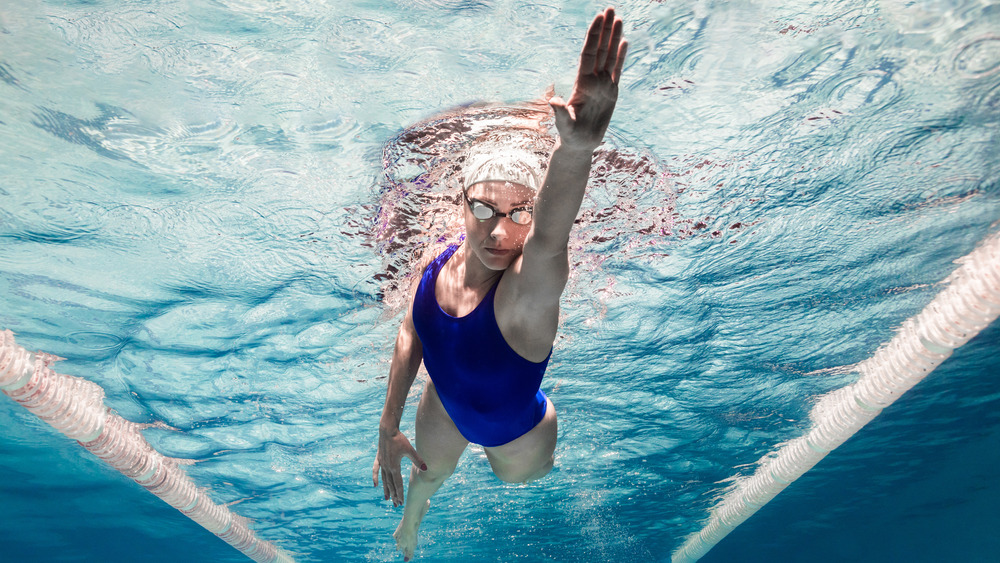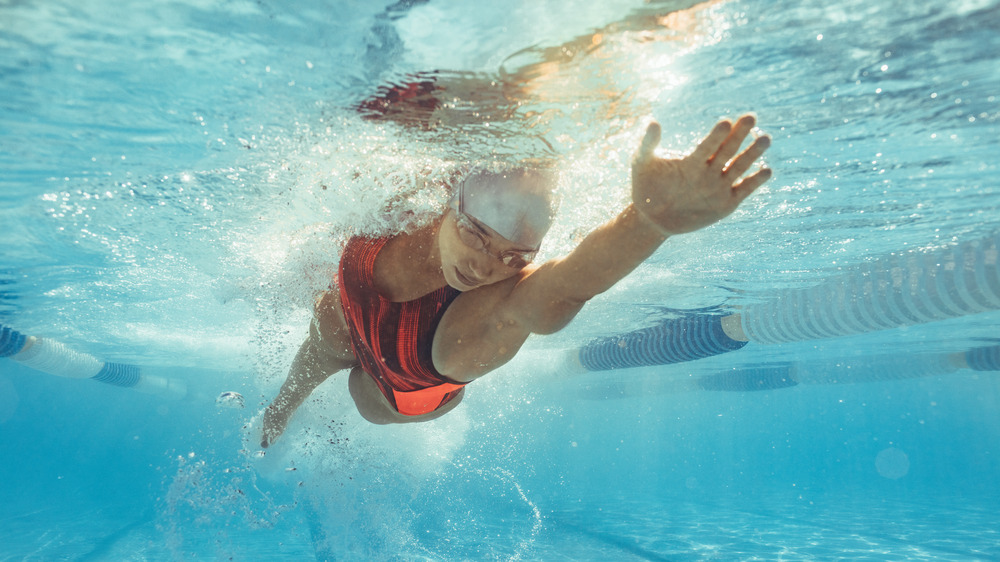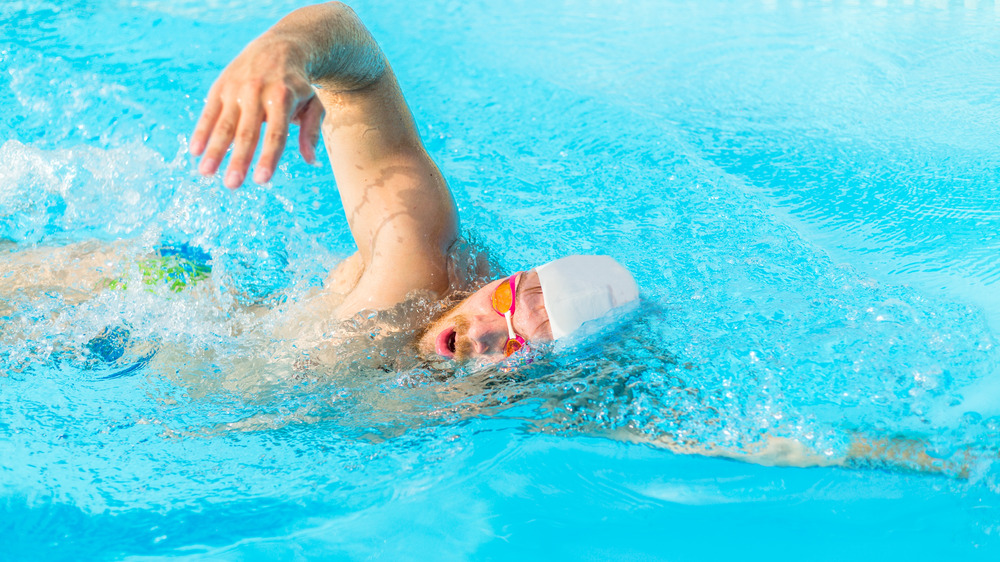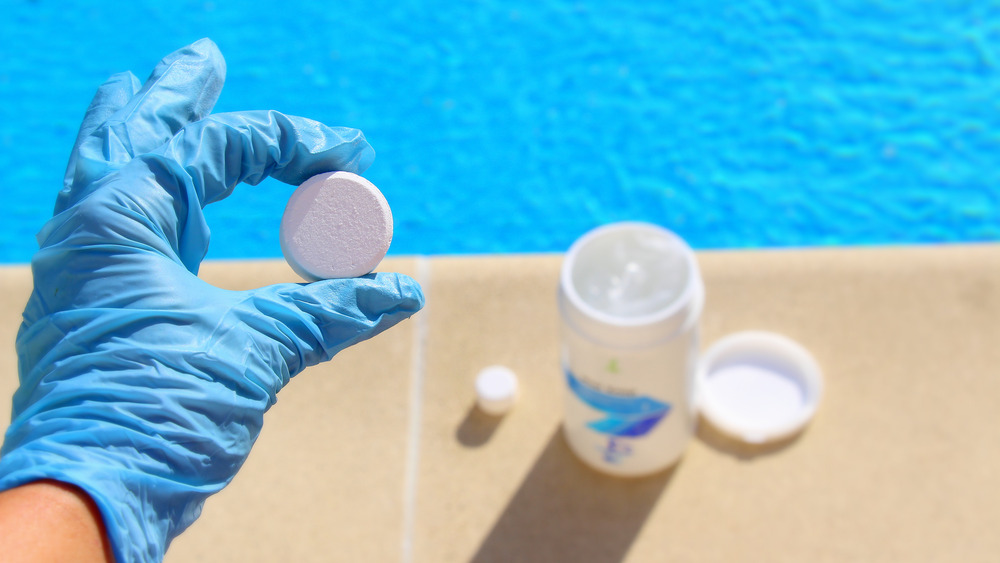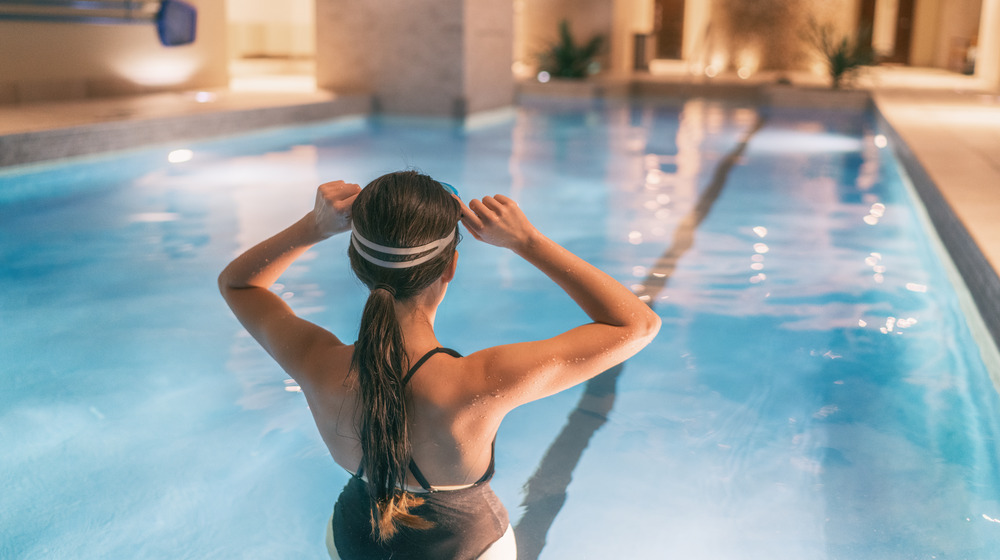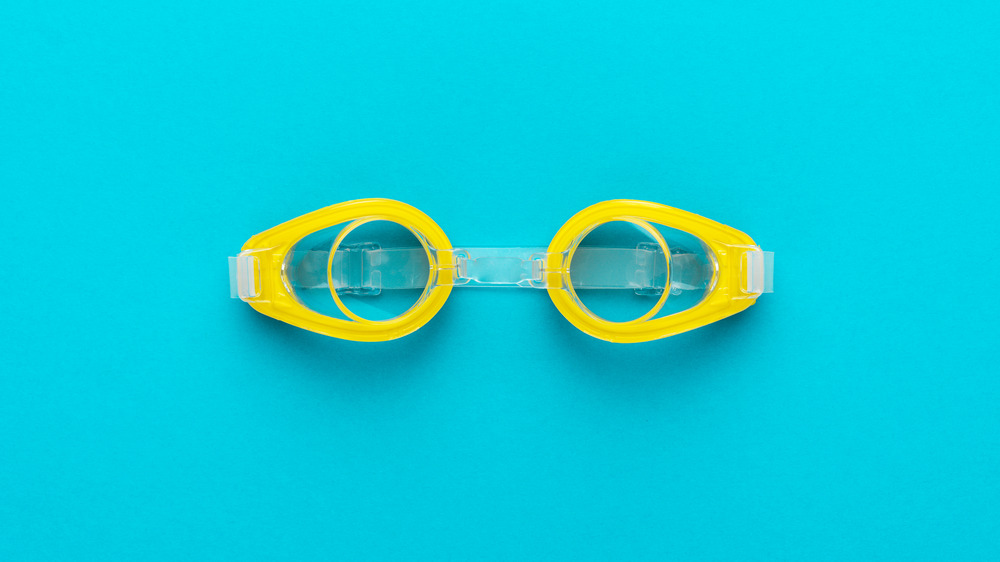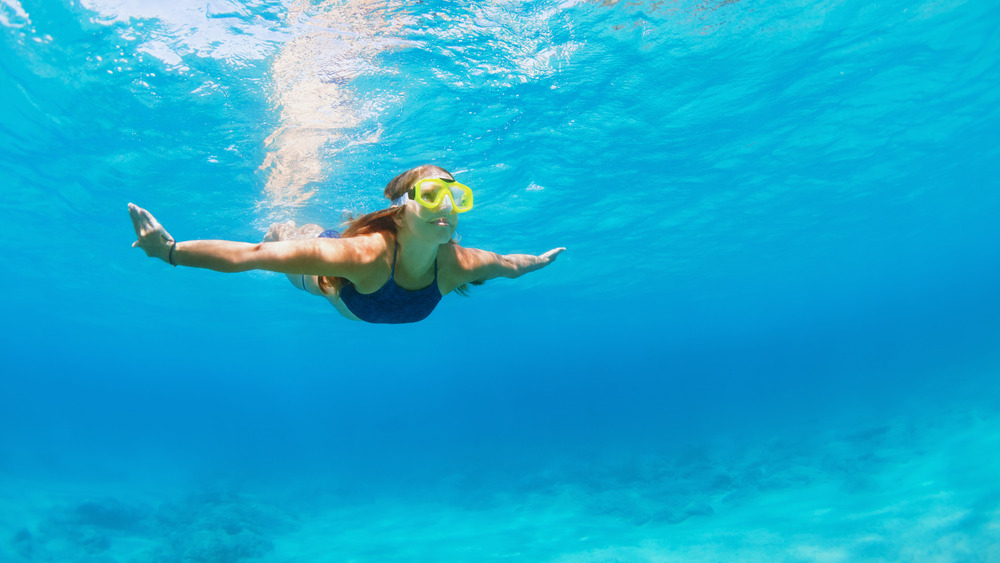When You Swim Every Day, This Is What Happens To Your Body
Whether you prefer the ocean, a lake, or a pool, swimming can be a wonderful way to work out. Instead of sweating while pounding the pavement during a run, you're floating in refreshing water while still giving your muscles a good exercise session. On the surface it sounds pretty perfect, but is it?
First, let's set the record straight: Swimming is officially considered a form of aerobic exercise or, more specifically, an exercise that involves coordinated muscle movements and emphasizes building endurance (via Medical News Today). A regular aerobic exercise routine can have a positive impact on a person's overall health. But it also can be risky for someone who has a preexisting cardiovascular condition like blood clots or has experienced a cardiac event such as a stroke. So you should always talk with your health care professional before adding any type of aerobic exercise to your routine.
While swimming really can be a wonderful way to work out, it does have its pros and cons. The good news is some of these cons are either avoidable or can be lessened if you are aware of them.
Swimming daily burns calories
The saying "a moment on the lips, a lifetime on the hips" sums up how many view weight and calories, but it doesn't tell the whole story. According to MyPlate.gov, a person's physical activity level is an important factor when calculating how many calories that person should eat. Think of it this way: An Olympic swimmer should consume more calories than a person who doesn't exercise because those calories help fuel their body for training and races.
Even if you're not training to be the next Michael Phelps, swimming can be one of the best aerobic exercise choices for burning calories (via Healthline). Typically, a person who weighs 160 pounds and exercises for an hour will burn a varying amount of calories based on the activity (183 calories doing yoga, 314 calories walking at 2.5 mph, and 365 calories moving on an elliptical trainer), according to Business Insider. That same person could burn 423 calories if they swim at a low or moderate pace for an hour, and a whopping 715 calories if they ramp up to a faster rate.
While it's tempting to go for the maximum calorie burn and try swimming hard and fast right away, it's important to pace yourself. Remember, aerobic exercise is about building endurance.
You risk damaging your hair if you swim each day
Do you usually wear a swim cap when you're in the pool? How about when you go to the beach and take a dip in the ocean? If you said no to either of these scenarios, then you might be doing some serious damage to your hair.
As dermatologist Melissa Piliang tells Shape, the chlorine in pool water "strips away the natural oils on your hair, leaving it dry and brittle." As for the ocean, Dr. Piliang explains, "Like chlorine, the salts in ocean water dry out your hair and damage the cuticle." Suddenly, that swim cap is looking better and better, but it isn't your only option.
According to Dr. Piliang, wetting your hair with fresh water before going swimming will help prevent it from absorbing water from the pool or ocean. Using a leave-in conditioner, she said, can also help protect your hair since "conditioner will further seal the fresh water in your hair." Finally, rinse your hair with fresh water right after a swim and add either more conditioner or oil to keep your hair moisturized.
Swimming tones the entire body
Actor Henry Cavill said he trained for two-and-a-half hours a day to get his body in shape to play Superman (via New York Daily News). Impressive, yes, but most of us don't have more than two hours for a daily workout. Heck, sometimes it seems like we barely have two minutes. This is a big reason why one exercise that works the entire body is so desirable — and swimming uniquely fills this need.
As Health explains, swimming efficiently tones every part of your body. No matter what type of swimming stroke you do, you're using the muscles in your arms and legs but beyond that, you're also engaging your core and working muscles in other less obvious parts of your body like your back. Plus, unlike other aerobic exercises where you might have to add arm or leg weights, no weights are needed for a good swimming session.
In addition to working out your entire body, swimming is also low impact (via Health). So, if you've recently been injured or just want to take it easy on your joints, this can be a good safe way to start or get back into a regular exercise routine.
You may find your daily swim irritates the skin on your shoulder
Do you shave your face? Do you have a 5 o'clock shadow? Or even just a little stubble? And most importantly, what does any of this have to do with your shoulder? Well, a lot actually, depending on what type of swimming stroke you do.
As WebMD explains, swimmers may experience a red patch of skin on the front of one shoulder around a half-hour after finishing a workout. The reason is actually quite simple. As a person swims, they may turn their head to breathe. In the process, their stubbly face brushes against their shoulder, irritating the skin. And while this won't happen if you do a breaststroke or a doggie paddle, the popular sidestroke could be problematic for the skin on your shoulders.
If you don't want to eliminate certain strokes from your swimming routine, a simple solution is to shave your face before you swim (via WebMD). But there is a catch. If you plan to swim at the beach, that salty ocean water will sting against freshly shaved skin.
Swimming can lower blood pressure
High blood pressure is a serious health issue that can cause a number of life-threatening problems. And while diet and medication can help treat this condition, research from Indiana University Bloomington's Counsilman Center for the Science of Swimming shows how swimming can also be invaluable for keeping your blood pressure in check and prolonging your life.
After conducting a series of tests on the United States Masters Swimmers who competed in the U.S. championships in 2004 and the FINA world championships at Stanford in 2006, the University researchers determined that the amount of swimming these athletes had done actually slowed down their aging. Specifically, they "substantially delayed the decline of such age markers as blood pressure, muscle mass, blood chemistry and pulmonary function," the university explained.
While these findings are very encouraging, you still need to be cautious before using swimming to manage your blood pressure. As Medical News Today notes, aerobic exercises like swimming can have risks for a person with certain preexisting cardiovascular conditions like high blood pressure. It's especially important to speak with your health care professional to set up the best workout routine for your health needs.
Depending on where you swim, you risk getting swimmer's itch
No, this isn't an overwhelming desire to go swimming. Swimmer's itch (cercarial dermatitis) happens when you go into warm water containing parasites (via Mayo Clinic). Not a pleasant thought, and equally unpleasant is what happens to your skin.
It may take a few minutes or a few days, but if those parasites burrow into your skin, you'll end up with an itchy, red rash, Mayo Clinic explained. How can you tell if a body of water has these parasites? Well, they live in the blood of certain birds and mammals. If you see animals like beavers, muskrats, geese, gulls, or ducks near a lake or pond, you may want to pick a different place to go swimming. Also, while these parasites are usually in fresh water, they can also be in salt water.
Now, before you permanently hang up your goggles, know this: Swimmer's itch usually clears up without any treatment needed. If you have a persistent case of it, though, there are medications to help. The two big things to keep in mind are don't scratch the rash to avoid infection and go to a health care professional if you see any pus.
A daily swim reduces stress
When you hear the word "hormones," do you immediately think of mood swings and health complications? Don't feel bad if you said yes. It's easy to focus on the negative, but remember, aerobic activities like swimming can improve your mood (via Medical News Today). In fact, a specific hormone helps with the stress-busting part of that emotional boost, per Aurora Health Care.
Have you ever heard the phrase "runner's high"? It happens when your body releases hormones called endorphins, which make you feel good even if you're doing something physically demanding, the health care company explained. And since running and swimming are both aerobic exercises, it's not surprising that swimming can also give you that natural high — no sneakers required.
Swimming also helps reduce stress because it can create mild sensory deprivation, according to Aurora Health Care. In other words, when you're underwater, you aren't hearing all the sounds you normally do. You also might not be seeing as many things as you would on land, even if you're wearing goggles. Use nose plugs and you won't take in as many smells. When swimming, your senses get a rest, and that alone can be calming.
Swimming in a pool daily can cause chlorine rash
Have you ever gone to a hotel or a gym with an indoor pool and noticed a strong chemical smell? In all likelihood, that scent was a disinfectant called chlorine. Now, chlorine is very important, especially if you have a pool with high traffic. But for swimmers, constantly soaking in chlorinated water can take a toll on their skin.
As Healthline explains, repeatedly swimming in pools treated with chlorine can lead your immune system to misidentify the disinfecting chemical as something dangerous like a virus. As a result, you may develop an itchy rash where your skin may be reddened, swollen, and tender, as well as crusty and scaly with hives and bumps. And if you think this is caused by an allergy to chlorine, know it can happen even if you just have a sensitivity to it.
The bad news is even rinsing off after a swim may not be enough to prevent a chlorine rash since some of the chemical will remain on your skin (via Healthline). Fortunately, there are over-the-counter products that can help, but seek medical help if you develop hives that won't disappear.
Swimming regularly helps control your blood sugar
Since swimming gives you a full-body workout, it's not surprising that it also helps control your blood sugar. Because swimming engages so many different types of muscles, those muscles in turn more quickly absorb the sugar from your blood, Verywell Health notes.
Obviously, swimming can be very beneficial for a person who is diabetic or pre-diabetic, but this blood sugar control goes beyond their initial workout. In fact, the effects of swimming on blood glucose levels can last for days after hitting the pool, the publication explained. Yes, you read that right. A diabetic who swims on Monday could still be seeing blood sugar level benefits on Wednesday.
Although there are some potentially very strong positives when it comes to swimming and blood sugar control, it can also be a double-edged sword. If you're swimming and begin to feel shaky, nauseous, fatigued, or dizzy, you may be experiencing hypoglycemia, a condition in which your blood sugar levels have dropped too low (via Verywell Health). If this happens, get out of the water immediately and have a snack.
Chemical conjunctivitis is a real risk if you swim in a pool regularly
Let's clear something up. Chemical conjunctivitis is not the same thing as the eye infection known as pink eye. Just as chlorine can cause a skin rash, it can also irritate your eyes, causing them to tear up, and become itchy and red (via U.S. Masters Swimming). And this eye issue often goes hand in hand with another one dubbed "swimmer's eye."
Your eyes' surfaces have a natural protective tear film made up of protein, water, and organic compounds called lipids. When you get water that has been treated with chlorine and saline in your eyes, the interaction of these disinfectants with the tear film causes the water part of it to evaporate. The result? Swimmer's eye. This condition is defined by red and "unlubricated" eyes, which makes them more susceptible to bacteria and more likely to develop chemical conjunctivitis, according to U.S. Masters Swimming.
A simple way to prevent chemical conjunctivitis is to wear goggles. Rinsing your eyes, eyelids, and eyelashes with fresh water can also help cleanse away chemicals (via U.S. Masters Swimming).
A daily swim can improve your brain health
Oftentimes in movies and TV shows, stereotypical "nerdy" characters constantly have their noses in books and are completely nonathletic. In reality, however, exercise like swimming can have a positive impact on your brain or, as the Cleveland Clinic puts it, on your "cognitive fitness."
"We know that physical exercise, and aerobic exercise in particular, is very beneficial for maintaining brain health, even in people who are at risk for developing dementia and Alzheimer's disease (AD)," Dr. Aaron Bonner-Jackson, a neuropsychologist, told the Cleveland Clinic. And according to the SwimRight Academy, exercise (including swimming) causes the part of your brain that deals with memory, the hippocampus, to expand. Plus, swimming encourages the creation of new nerve cells or neurons in your hippocampus. In short, swimming can help your brain with memory and learning.
Dr. Bonner-Jackson recommends 150 minutes of moderate aerobic exercise per week and suggests swimming as a good activity to accomplish this. However, everyone's health is different so speak with your own health care professional before adding this amount of exercise to your routine.
If you swim in the Atlantic or Caribbean, you could get seabather's eruption
Seabather's eruption is also known as pica-pica. Aand while that might sound like something from Pokémon Go, it's actually a skin rash that can happen to people who swim in the waters off Long Island, New York or Florida's coasts, as well as the Caribbean Sea, according to the American Academy of Dermatology Association (AAD).
Now for the unpleasant part. Seabather's eruption occurs when you get baby jellyfish or sea anemones trapped in your bathing suit or other swim gear like swim fins, the AAD explained. But wait, wouldn't you see these sea creatures? How small can they really be? Well, when they're newly hatched, they can be as tiny as a speck of pepper. And a sure sign you've probably got pica-pica is your skin is stinging when you rub it.
With seabather's eruption, the best thing to do is, naturally, avoid water swarming with newly hatched sea anemones and jellyfish. While you likely wouldn't be able to spot them with your eyes, you may see a sign at the beach warning you of the infested water. And keep your ears open; if someone complains about having a rash after going into the water, swim someplace else.
You'll sleep better after swimming
When you swim, your body releases stress-busting hormones called endorphins (via Aurora Health Care). As such, it's not necessarily a shock that this form of exercise can help you get a better night's sleep.
According to Women's Health, aerobic exercises like swimming not only help you stay asleep throughout the night but also help you achieve good quality sleep. Remember, there are different phases to sleep, and the more time you spend in deep sleep and REM (rapid eye movement) sleep, the more restorative that sleep will be for your mind and body (via PIH Health).
If you often have trouble falling asleep or even staying asleep, consider hitting the pool. A 2011 study in Sleep Medicine found 17 adults over 55 years old who suffered from insomnia improved their sleep health in part by engaging in aerobic activity. With it's stress-taming, mood-boosting bonuses, swimming seems to be a great choice for quality sleep (via Medical News Today). However, the study did point out that proper sleep hygiene is also crucial, so it's important to set up a relaxing nighttime routine.
Swimming every day may lead to swimmer's ear
It can certainly look funny when someone is jumping up and down, shaking their head as they try to dislodge some water trapped in their ear. However, water that remains trapped in the ear for too long can lead to a sometimes serious type of ear infection known as otitis externa or swimmer's ear, according to the Mayo Clinic.
When water gets trapped inside your ear, it creates the perfect situation for bacteria to grow and cause an infection in your outer ear canal. Symptoms can range from mild (itching and slight discomfort) to moderate (muffled hearing and redness inside your ear) to even severe (fever and severe pain that spreads to your face or neck).
Fortunately, there are treatments for swimmer's ear, but you need to see your health care provider even if you're only experiencing mild symptoms, per the Mayo Clinic. Any delay could allow the infection to spread and become more severe. If you develop a fever or are in severe pain after getting water in your ear, you are likely dealing with an advanced case of swimmer's ear and need to treat it as a medical emergency.

